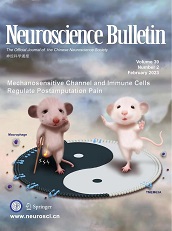Administration: Chinese Academy of Sciences
Sponsors: Center for Excellence in Brain Science and Intelligence Technology (Institute of Neuroscience), CAS and Chinese Neuroscience Society
Editor-in-Chief: Shumin Duan
Co-Editor-in-Chief: Ru-Rong Ji
Publication Number: ISSN 1673-7067, CN 31-1975/R
Publication Frequency: Monthly
Address of Editorial Office:
319 YueYang Road, Room 612, Building 8, Shanghai 200031, China.
Phone: +86-21-64032273; 64032563; 64170853; 64032696;
E-mail: nsb@ion.ac.cn
http://www.neurosci.cn
 [Cover]
[Cover]